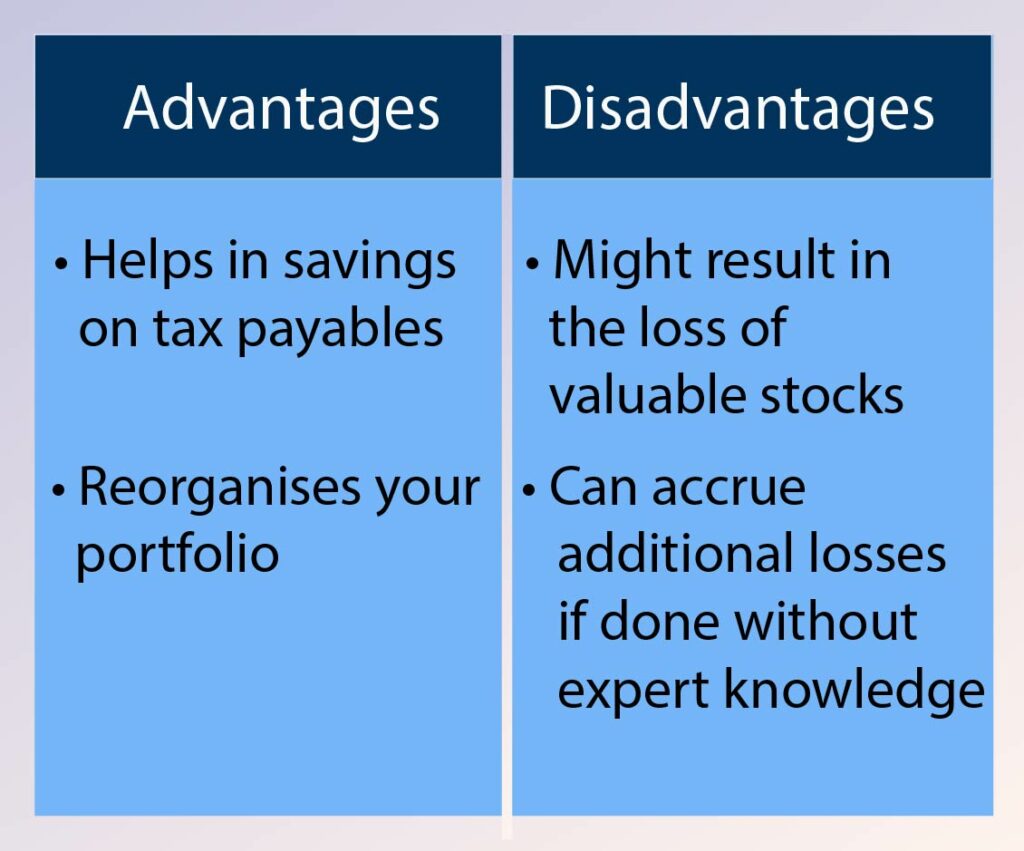Tax-loss harvesting is a fundamental strategy for reducing tax payables and increasing capital gains by paying less in taxes. This strategy is provided for the benefit of investors and traders by the law to reduce the tax outgo on realised gains before the end of a financial year by booking a sell order on loss-making stocks.
One of the most critical aspects of tax-loss harvesting is: does it help increase return on investment? The simple answer is yes. As it helps you cut down the payable tax, it automatically enhances post-tax capital gains. Let us dive further into why it is a widely used practice in Indian securities markets and what can be the ups and downs of this tax-saving process.
The lack of wash sale rule in India
One factor that makes tax-loss harvesting profitable in India is the lack of legislation for wash sales. A wash sale proceeds when you sell a security at a loss and repurchase it or substantially identical security shortly before or after.
Technically, the wash sale rule is an American regulation that applies only to the United States securities market. Under the US wash sale rules, investors cannot use the loss accrued from a sale to set off their capital gains and reduce the tax liability.
Unlike the US, there is no provision for wash sales in India, which means that Indian investors and traders can use it to reduce tax losses without any consequences of reprimanding action by the tax authorities.
Example
Sample this. You hold a share of Vodafone-Idea. Suppose the share price drops from Rs. 100 (your buy price) to Rs. 60, meaning that you currently have an unrealised loss of around Rs. 40.
At the same time, you also hold a share of HCL Technologies. Assume that the share price of the HCL stock has risen from the buy price of Rs. 2,000 to around Rs. 2,100. Now, you have an unrealised profit of around Rs. 100. You subsequently decide to sell this share for a profit of Rs. 100.
Now, the profit of Rs. 100 is the capital gain on which you are required to pay tax. However, to reduce the tax liability, you also sell off the Vodafone-Idea share that you had for Rs. 60. This way, you can effectively make a loss of Rs. 40 on this transaction, and the tax will be levied on Rs. 60 instead of Rs. 100, thereby reducing your tax liability.
But then, you don’t wish to let go of the Vodafone-Idea share. And so, you simultaneously rebuy the share of Vodafone-Idea at Rs. 60. Such transactions are known as wash sale transactions.
‘‘
Reduced tax liabilities are undoubtedly the most prominent benefits of tax-loss harvesting. It not only helps investors but is also very helpful for traders.
Benefits of tax-loss harvesting for traders
For a stock market trader, every profit and loss in the market matters a lot due to the short-period nature of the trading activity. So if you have net realised business gain (short term capital gain, long term capital gain, Futures & Options profits), you are liable to pay up to 30% taxes on these gains.
However, you can deduct this tax liability by using tax-loss harvesting by realising the loss in trade transactions. With the sale of loss-making entities, which are giving either a short term or long term capital loss, you can reduce tax costs.
Once you sell the stock, you can either rebuy a similar stock instantly or wait for the stocks to go out from your Demat and then repurchase the same stock two days later.
Reorganise your portfolio
One of the best things about tax-loss harvesting is the ability to reorganise your portfolio. Reorganisation of the portfolio helps in improving the balance between wealth, profit and risk.
When indulging in refinancing via tax-loss harvesting, look at which holdings to sell or buy, and pay heed to the cost principle (the adjusted, initial purchase price). The cost basis will determine the capital gains or losses on each asset. The cost basis will determine the capital gains or losses on each asset. This method prevents you from selling only to realise a tax loss that may or may not fit your investment strategy.
Some downsides of tax-loss harvesting
Everyone wants to reduce tax payments on their hard-earned money and therefore look to tax-loss harvesting as a primary method. But assets that are down are not necessarily a bad thing in the stock market. If a down stock is the one that can provide diversification benefits and balance your long-term returns, such a stock strongly rings the buy bells.
Some experts consider tax-loss harvesting a fundamentally flawed approach as it involves selling loss-making stocks. Their sale can lead to the loss, although temporary, of important diversifiers in a portfolio for a relatively small tax saving.

Short versus long-term
As an investor, you need to look for long term benefits. And that sometimes includes buying into uncorrelated assets that have depreciated during a rapidly changing market regardless of the confidence one might have in the extension of equity increase.
Long-term losses on securities held for more than a year are generally netted against any long-term capital gains. In contrast, short-term losses on the sale of securities held for less than a year get applied to short-term gains, which are taxed at your higher ordinary income tax rate.
It is also essential to know that harvesting losses can add additional burdens, regardless of which tax bracket (10% or 15%) you belong to. To get the best possible benefits from your tax-loss harvesting, it is always advisable to consult an experienced financial advisor.
Since India does not have a wash sale rule, you can use wash sales transactions to limit your tax burden. However, you should carefully examine your overall returns because a careless strategy can lead to a net loss in the name of reducing tax burden through a wash sale.
In the end, the Indian financial markets and the laws regulating them give investors a fair chance to utilise the tax-saving benefit from tax-loss harvesting. Remember, the technique should be used as per your own goals, risk capability, financial knowledge, and with a greater understanding of the process.




